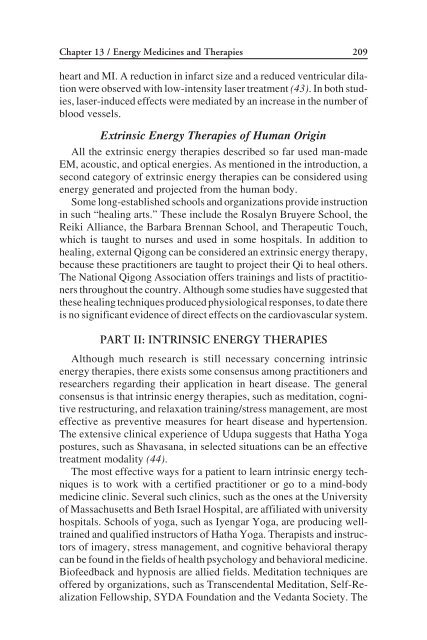Complementary Alternative Cardiovascular Medicine
Complementary Alternative Cardiovascular Medicine
Complementary Alternative Cardiovascular Medicine
You also want an ePaper? Increase the reach of your titles
YUMPU automatically turns print PDFs into web optimized ePapers that Google loves.
Chapter 13 / Energy <strong>Medicine</strong>s and Therapies 209<br />
heart and MI. A reduction in infarct size and a reduced ventricular dilation<br />
were observed with low-intensity laser treatment (43). In both studies,<br />
laser-induced effects were mediated by an increase in the number of<br />
blood vessels.<br />
Extrinsic Energy Therapies of Human Origin<br />
All the extrinsic energy therapies described so far used man-made<br />
EM, acoustic, and optical energies. As mentioned in the introduction, a<br />
second category of extrinsic energy therapies can be considered using<br />
energy generated and projected from the human body.<br />
Some long-established schools and organizations provide instruction<br />
in such “healing arts.” These include the Rosalyn Bruyere School, the<br />
Reiki Alliance, the Barbara Brennan School, and Therapeutic Touch,<br />
which is taught to nurses and used in some hospitals. In addition to<br />
healing, external Qigong can be considered an extrinsic energy therapy,<br />
because these practitioners are taught to project their Qi to heal others.<br />
The National Qigong Association offers trainings and lists of practitioners<br />
throughout the country. Although some studies have suggested that<br />
these healing techniques produced physiological responses, to date there<br />
is no significant evidence of direct effects on the cardiovascular system.<br />
PART II: INTRINSIC ENERGY THERAPIES<br />
Although much research is still necessary concerning intrinsic<br />
energy therapies, there exists some consensus among practitioners and<br />
researchers regarding their application in heart disease. The general<br />
consensus is that intrinsic energy therapies, such as meditation, cognitive<br />
restructuring, and relaxation training/stress management, are most<br />
effective as preventive measures for heart disease and hypertension.<br />
The extensive clinical experience of Udupa suggests that Hatha Yoga<br />
postures, such as Shavasana, in selected situations can be an effective<br />
treatment modality (44).<br />
The most effective ways for a patient to learn intrinsic energy techniques<br />
is to work with a certified practitioner or go to a mind-body<br />
medicine clinic. Several such clinics, such as the ones at the University<br />
of Massachusetts and Beth Israel Hospital, are affiliated with university<br />
hospitals. Schools of yoga, such as Iyengar Yoga, are producing welltrained<br />
and qualified instructors of Hatha Yoga. Therapists and instructors<br />
of imagery, stress management, and cognitive behavioral therapy<br />
can be found in the fields of health psychology and behavioral medicine.<br />
Biofeedback and hypnosis are allied fields. Meditation techniques are<br />
offered by organizations, such as Transcendental Meditation, Self-Realization<br />
Fellowship, SYDA Foundation and the Vedanta Society. The


